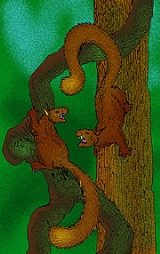
Kopidodon
Encyclopedia
Kopidodon is a genus of extinct squirrel
-like mammal
s belonging to the order Cimolesta
. Kopidodon was one of the largest tree-dwelling mammals known from Eocene
Europe
: growing 115 centimeters long (most of that length is tail). This mammal sported fearsome canine teeth, probably for defense. However its molars were designed for chewing plants, not flesh. Its legs and claws allowed Kopidodon to scramble through the trees with the greatest of ease, much like modern-day squirrels. Its fossils were found in the Messel pit
, preserving even its fur. We know that like a giant squirrel
, Kopidodon had a thick bushy tail for balance.
Squirrel
Squirrels belong to a large family of small or medium-sized rodents called the Sciuridae. The family includes tree squirrels, ground squirrels, chipmunks, marmots , flying squirrels, and prairie dogs. Squirrels are indigenous to the Americas, Eurasia, and Africa and have been introduced to Australia...
-like mammal
Mammal
Mammals are members of a class of air-breathing vertebrate animals characterised by the possession of endothermy, hair, three middle ear bones, and mammary glands functional in mothers with young...
s belonging to the order Cimolesta
Cimolesta
Cimolesta is an extinct order of mammals. A few experts place the pangolins within Cimolesta, though most other experts prefer to place the pangolins within their own order, Pholidota....
. Kopidodon was one of the largest tree-dwelling mammals known from Eocene
Eocene
The Eocene Epoch, lasting from about 56 to 34 million years ago , is a major division of the geologic timescale and the second epoch of the Paleogene Period in the Cenozoic Era. The Eocene spans the time from the end of the Palaeocene Epoch to the beginning of the Oligocene Epoch. The start of the...
Europe
Europe
Europe is, by convention, one of the world's seven continents. Comprising the westernmost peninsula of Eurasia, Europe is generally 'divided' from Asia to its east by the watershed divides of the Ural and Caucasus Mountains, the Ural River, the Caspian and Black Seas, and the waterways connecting...
: growing 115 centimeters long (most of that length is tail). This mammal sported fearsome canine teeth, probably for defense. However its molars were designed for chewing plants, not flesh. Its legs and claws allowed Kopidodon to scramble through the trees with the greatest of ease, much like modern-day squirrels. Its fossils were found in the Messel pit
Messel pit
The Messel Pit is a disused quarry near the village of Messel, about southeast of Frankfurt am Main, Germany. Bituminous shale was mined there. Because of its abundance of fossils, it has significant geological and scientific importance...
, preserving even its fur. We know that like a giant squirrel
Squirrel
Squirrels belong to a large family of small or medium-sized rodents called the Sciuridae. The family includes tree squirrels, ground squirrels, chipmunks, marmots , flying squirrels, and prairie dogs. Squirrels are indigenous to the Americas, Eurasia, and Africa and have been introduced to Australia...
, Kopidodon had a thick bushy tail for balance.

